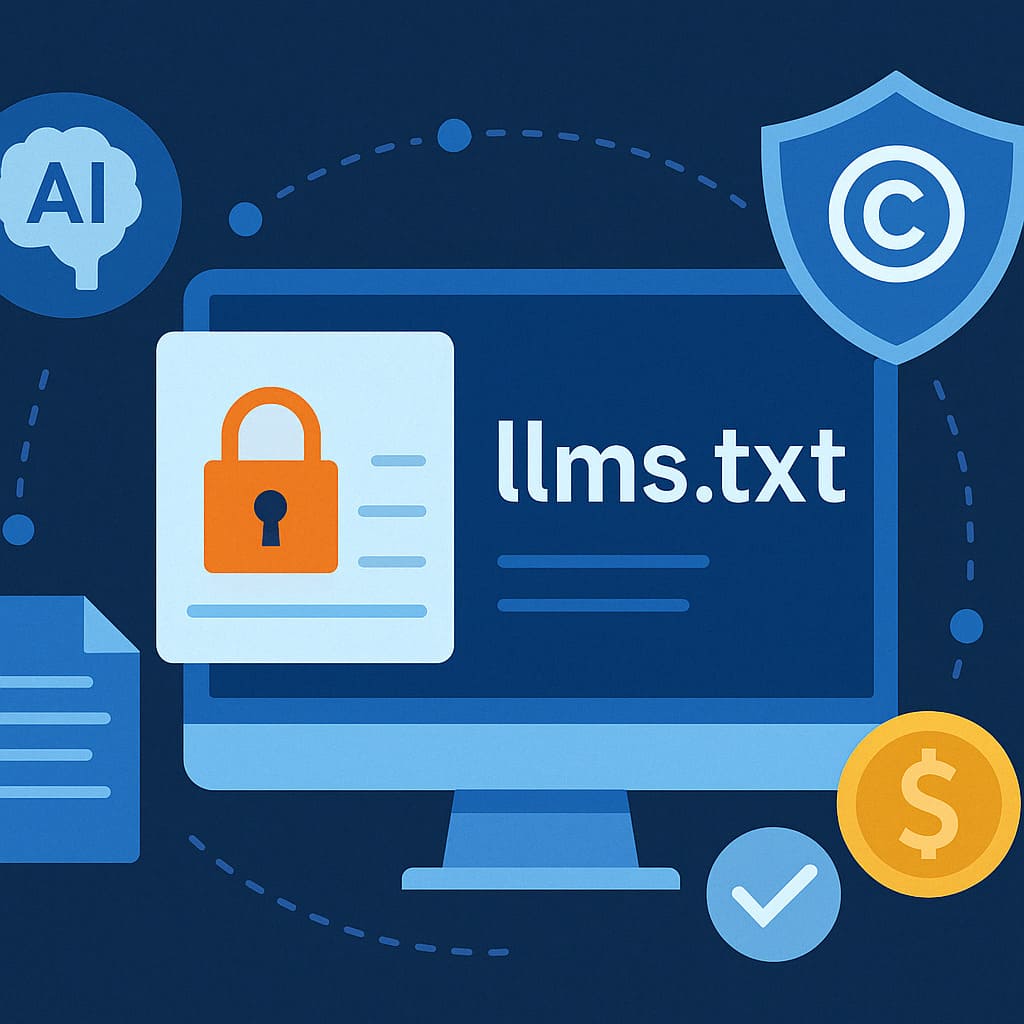Future of Content Ownership in AI World: How LLMs.txt Helps You Protect & License Content
- Posted 3 days ago
In the rapidly evolving digital landscape, content ownership is becoming an increasingly important topic. As artificial intelligence (AI) continues to reshape industries, particularly in the realm of content creation, the traditional boundaries of content ownership are being tested. The rise of AI-driven tools, including language models like GPT, has brought forth new questions regarding who owns the content generated by AI and how to protect that content from misuse.
One tool that can play a significant role in ensuring content protection and licensing in the AI world is LLMs.txt. This file format, designed to control AI bots and crawlers’ access to specific content, can serve as an essential layer for establishing content usage policies and acting as a “terms of use” layer for AI-driven content consumption. In this blog post, we will explore the future of content ownership in the AI era and how LLMs.txt can help website owners protect and license their content effectively.
Content Usage Policies in the AI Era
As AI technology evolves, so too does the complexity surrounding content usage policies. Content creators—whether they are writers, designers, musicians, or software developers—have long held the rights to their work. However, as AI begins to generate content based on the data it is trained on, the concept of ownership becomes less clear. For instance, if an AI tool generates a piece of content, is it owned by the AI developer, the user who instructed the AI, or the source data itself?
In the context of e-commerce sites, media outlets, or even personal blogs, it’s critical to establish clear content usage policies. This includes understanding the extent to which AI systems can access, use, and redistribute your content. Without proper content usage policies, businesses risk unauthorized usage of their work by AI bots or other digital agents.
Key Considerations for Content Usage Policies
- Content Access Control: How much access do AI bots have to your content? Can they scrape entire articles, product listings, or other forms of content? Setting clear access guidelines is crucial.
- Licensing: How do you license content for AI use? Can AI tools or other platforms use your content to train models, or is it off-limits for reproduction?
- Redistribution Rights: Should AI-generated content based on your work be allowed to be redistributed by AI engines or other websites? If so, under what conditions?
In an ideal world, these policies would be enforceable in a way that balances content creation with fair usage. As AI continues to develop, tools like LLMs.txt will help define and protect these boundaries.
The Legal and Ethical Aspects of AI Content Consumption

The legal and ethical implications of AI content consumption are some of the most debated issues in the modern digital landscape. As AI tools scrape content, generate new text, or curate digital assets, the rights of the original content creators are often in question. It’s essential to address both the legal aspects and the ethical considerations of content consumption in the AI world.
Legal Aspects of AI Content Consumption
The legal framework around content ownership is complex and varies by jurisdiction. In the case of AI-generated content, questions arise about copyright infringement, data protection, and intellectual property rights.
- Copyright Protection: Does AI-generated content qualify for copyright protection? Currently, copyright law generally grants ownership to human creators, not AI systems. However, if AI-generated content is used without permission or attribution, it could be seen as infringement of the original content creator’s intellectual property.
- Data Scraping and Usage: If AI tools scrape content from a website, is the content owner’s intellectual property being misused? Websites that host original content must ensure that AI crawlers don’t violate their rights, especially when content is used for commercial purposes.
- Fair Use Doctrine: Under copyright law, there’s the concept of “fair use,” which allows for limited use of content without permission for purposes like commentary, criticism, or research. However, this doesn’t always cover the use of content by AI tools, and this legal grey area needs to be addressed.
Ethical Considerations
Beyond the legal framework, the ethical implications of AI content consumption are just as critical. AI tools that scrape content from websites and use it to generate new material must be transparent and respectful of content creators’ rights. For instance, if AI tools use user-generated content without proper attribution, it can lead to ethical concerns regarding plagiarism and misrepresentation.
Additionally, AI-generated content often lacks human oversight, which can result in the spreading of misinformation, misrepresentation, or biased narratives. Ethical AI consumption requires accountability for the quality and fairness of generated content, especially if it is based on data scraped from the web.
How LLMs.txt Acts as a “Terms of Use” Layer
One of the most effective ways to protect your content in the AI-driven world is through LLMs.txt, a simple yet powerful tool that acts like a “terms of use” layer for AI bots. LLMs.txt is a text file format that allows website owners to control how AI crawlers interact with their content. By defining the rules of engagement, LLMs.txt ensures that AI engines only access content under specified conditions.
What LLMs.txt Does
LLMs.txt allows you to define rules for AI bots on your website. These rules specify what content is allowed to be crawled, indexed, and used by AI systems. By including LLMs.txt in your website’s root directory, you can establish boundaries for AI bots, preventing unwanted or unauthorized use of your content.
Here are a few key ways LLMs.txt can be used as a terms of use layer:
1. Defining Content Access Rules
In the same way a website’s privacy policy outlines how users interact with content, LLMs.txt can outline how AI bots can engage with your content. For example:
txtCopyUser-agent: AI_Crawler
Disallow: /private/
Allow: /public/
This rule prevents AI bots from accessing certain private sections of your website (such as internal documents or confidential data) while allowing them to crawl and index public content.
2. Granting or Denying Content Usage Rights
LLMs.txt can also serve as a way to grant or deny certain usage rights. For example, you might want to specify that content can be indexed but not used for training AI models:
txtCopyUser-agent: AI_Crawler
Disallow: /content/
Allow: /content/index/
No-Use: /content/
In this case, AI crawlers are allowed to index content, but they are explicitly prohibited from using that content in any training datasets.
3. Preventing Scraping of Specific Content Types
If your website hosts valuable content like product descriptions or blog posts, you may wish to prevent AI bots from scraping and using this content without permission. LLMs.txt gives you the ability to selectively block or allow access to different types of content, ensuring that only authorized AI tools can interact with your intellectual property.
txtCopyUser-agent: ChatGPTBot
Disallow: /product-page/
Allow: /product-page/summary/
This rule ensures that the AI bot can access summaries or metadata related to products, but not the full product pages.
4. Ensuring Attribution and Licensing Compliance
For e-commerce sites or blogs, LLMs.txt can also enforce attribution by ensuring that AI tools attribute the content correctly. While LLMs.txt cannot directly enforce this, it can be used to specify guidelines for AI crawlers that help uphold the ethical and legal principles of content usage.
txtCopyUser-agent: AI_Crawler
Disallow: /content/
Allow: /content/attribution-required/
5. Transparency for AI Usage
Another important aspect of LLMs.txt is that it promotes transparency in AI content usage. By clearly defining the content that is accessible to AI engines, you can ensure that your content is being used responsibly and in compliance with your stated content policies.
Read Also : Can LLMs.txt Improve Your Website’s AI Rankings? (Case Studies + Experiments)
Conclusion: Protecting Content in an AI-Driven Future
As AI continues to shape the digital landscape, the future of content ownership is shifting. It’s no longer enough to rely on traditional copyright laws alone to protect intellectual property. The rise of AI-driven content generation requires new approaches to content protection and licensing.
LLMs.txt offers an essential tool for website owners to protect their content and ensure that AI crawlers are only using it in ways that align with their policies. By defining content access, usage rights, and attribution requirements, LLMs.txt serves as a “terms of use” layer, ensuring ethical and legal compliance in the age of AI.
As we move forward, it’s crucial for content creators to embrace new technologies like LLMs.txt to protect their work while maintaining control over how their content is consumed and used.

